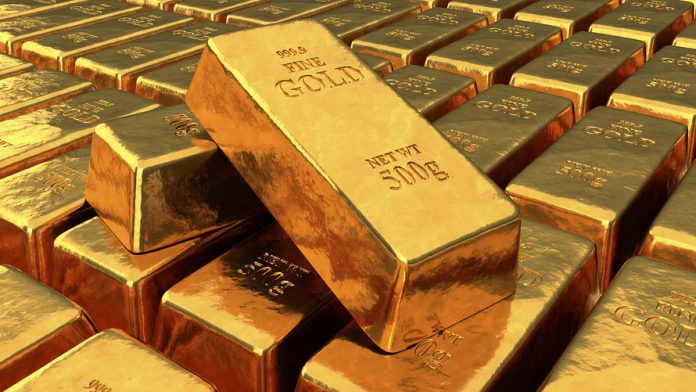Gold is set to shine
Just under one-tenth (9.2%) of Kuwait’s foreign reserves ($40.6 billion) are in gold, and Kuwait’s gold reserves currently stand at around 79 tonnes. This should prove to be good financial support for the nation as market conditions appear almost perfect for a strong rise in gold prices over the next 12 months. This article explores the historical increases we witnessed in gold’s prices and why current market conditions are advantageous for expectations of a further increase in gold’s price.
What was behind gold’s two biggest rallies of the last 50 years?
Looking at the chart below we can see two major bull runs experienced by gold in the last 50 years. The first big gold rally came when Governments gave up control of gold prices and relaxed private ownership rules around 1970.
The second major bull rally was between 2003 and 2011 when the annual demand for gold increased from 2600 tonnes to 4700+ tonnes. Gold prices were helped by coordinated interest rate cuts from central banks around the world. Investors seeking alpha were once again drawn to the safe-haven status of gold. In fact, we are seeing a very similar response by central banks to the COVID-19 crisis to the one we saw during the Global Financial Crisis of 2008/09, namely the coordinated cutting of interest rates around the world. Some central banks even have negative interest rates now including the European Central Bank, the Swiss National Bank and the Bank of Japan.
Recession
Countries across the world are entering recessions brought about by a slowdown in growth due to COVID-19. In recessions, gold tends to shine very brightly; during each of the three most-recent major recessions in 1990-91, 2001, and 2007-2009, gold increased in value. Gold is historically good to hedge into recessions and many investors are already adding to their gold holdings.
Look at the chart below for gold’s increase over the last few recessions:
Gold, bond prices, and the US dollar
With many central banks moving down towards zero interest rates, and some central banks already having negative interest rates, investors are encouraged to move into gold. If the level of inflation is higher than a country’s interest rate, money in the bank loses value. Ouch! This makes gold an attractive option for investors who want to try and hedge some of the risk involved in staying in cash.
Furthermore, as bond yields fall and the risk of inflation increases, assets and currencies also start to devalue. With central banks asset-buying so heavily via large quantitative easing programmes across the world this essentially ends up diluting the value of the currency. If you look back on the great financial crisis of 2008 you can see that gold bottomed when the Federal Reserve launched its quantitative easing programme. The rallies that ensued were historic, with gold nearly tripling and silver rallying nearly 500% during that period. Currencies are starting to devalue now and this increases the appeal of gold. Have a look at the gold, bond and USD chart below and notice that while US bond yields fall, gold buyers grow:
Gold sales down in China and India
One area of gold purchases that have fallen during the first few months of the year is jewellery demand. Unsurprisingly, the COVID-19 pandemic has heavily reduced jewellery demand for the 1st quarter as governments across the globe imposed lockdown measures. Demand for jewellery fell to its lowest on record. This has been led by a 65% decline in China, the largest jewellery consumer, and the first market to succumb to the outbreak. A key point to note is that once lockdowns are lifted we can expect to see jewellery demand rise again and, in conjunction with more ETF buying, should push gold demand much higher next quarter. Take a look at this chart below and look at the ETF and jewellery levels of demand in particular.
Exchange-Traded Fund holdings grow
Holdings of exchange-traded funds are now at record highs, supporting gold demand. According to the World Gold Council levels of ETF holdings are now at an all-time high of 3,355 tonnes. Assets under management also reached a new record high of $184bn as gold in US dollars (XAUUSD) moved higher by 5.8%. Furthermore, low-cost gold-backed ETFs in the US have seen positive flows for 22 of the past 23 months. They have increased their collective assets to 91t, which amounts to roughly the holdings of all Asian-based funds. So, although ETF holdings in gold are high this year they are still relatively low compared to total ETF holding levels which are over $6 trillion. So, there is plenty of room for further moves into ETF holdings. It is also interesting to note that in April, North American funds had large gold ETF inflows of 144t (US$7.8bn, 8.3% AUM) indicating that demand is picking up the pace.
The downside risk for gold
One area of concern for gold going forward is that investors sell gold as a last resort at times of intense fear. You may have noticed during the height of the COVID-19 crisis that when equity markets were being sold heavily gold was being sold at the same time. If markets see heightened levels of fear and volatility again we will expect to see gold being sold temporally. However, even if that happens on a second COVID-19 wave, the long-term picture for gold remains bullish which will support Kuwait’s economy via its gold holdings. This really does look like gold’s time to shine.
By Giles Coghlan
Chief Currency Analyst at HYCM
References:
https://tradingeconomics.com/kuwait/gold-reserves
https://www.gold.org/goldhub/research/gold-demand-trends/gold-demand-trends-q1-2020
https://www.gold.org/goldhub/data/global-gold-backed-etf-holdings-and-flows
https://www.statista.com/topics/2365/exchange-traded-funds/



























